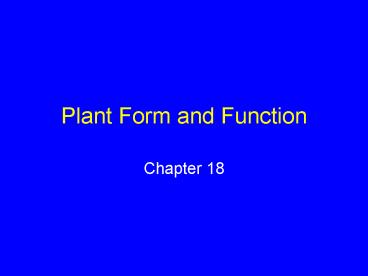Plant Form and Function - PowerPoint PPT Presentation
1 / 22
Title:
Plant Form and Function
Description:
Main conducting cells are sieve-tube members. Companion cells ... PALISADE. MESOPHYLL. SPONGY. MESOPHYLL. LOWER. EPIDERMIS. one stoma. cuticle. O2. CO2. xylem ... – PowerPoint PPT presentation
Number of Views:1475
Avg rating:3.0/5.0
Title: Plant Form and Function
1
Plant Form and Function
- Chapter 18
2
Vascular Tissues
- Xylem
- Conducts water and dissolved minerals
- Conducting cells are dead and hollow at maturity
- Phloem
- Transports sugars
- Main conducting cells are sieve-tube members
- Companion cells assist in the loading of sugars
3
Adapted for Photosynthesis
- Leaves are usually thin
- High surface area-to-volume ratio
- Promotes diffusion of carbon dioxide in, oxygen
out - Leaves are arranged to capture sunlight
- Are held perpendicular to rays of sun
- Arranged so they dont shade one another
4
Leaf Structure
UPPER EPIDERMIS
cuticle
PALISADE MESOPHYLL
xylem
SPONGY MESOPHYLL
phloem
LOWER EPIDERMIS
one stoma
CO2
O2
5
Leaf Veins Vascular Bundles
- Xylem and phloem often strengthened with fibers
- In eudicots, veins are netlike
- In monocots, they are parallel
6
Plant Nutritional Requirements
- Nearly all plants are photoautotrophs
- Require carbon dioxide, water, minerals
- Many aspects of plant structure are responses to
low concentrations of these vital resources in
the environment
7
Macronutrients
- Mineral elements that are required in amounts
above 0.5 of the plants dry weight - Carbon Nitrogen Magnesium
- Hydrogen Potassium Phosphorus
- Oxygen Calcium Sulfur
8
Micronutrients
- Elements that are required in trace amounts for
normal plant growth - Chlorine Zinc
- Iron Copper
- Boron Molybdenum
- Manganese
9
Root Hairs
- Extensions from the root epidermis
- Greatly increase the surface area available for
absorption
10
Root Nodules
- Swelling on the roots of some plants
- Contain nitrogen-fixing bacteria
- Bacteria converts nitrogen gas to forms that
plants can use
11
Mycorrhizae
- Symbiosis between a young plant root and a fungus
- Fungal filaments may cover root or penetrate it
- Fungus absorbs sugars and nitrogen from the plant
- Roots obtain minerals absorbed from soil by
fungus
12
Water Use and Loss
- Plants use a small amount of water for metabolism
- Most absorbed water lost to evaporation through
stomata in leaves - Evaporation of water from plant parts is
transpiration
13
Water Transport
- Water moves through xylem
- Xylem cells are tracheids or vessel members
- Both are dead at maturity
14
Cohesion-Tension Theory of Water Transport
- Transpiration creates negative tensions in xylem
- Tensions extend downward from leaves to roots
- Hydrogen-bonded water molecules are pulled upward
through xylem as continuous columns
15
Transpiration Drives Water Transport
Water evaporates from leaves through stomata
Creates a tension in water column in xylem
16
Replacement Water Is Drawn in through Roots
17
Osmosis and Wilting
- Water responds to solute concentrations moves
osmotically into plant cells - When water loss is balanced by osmotically
induced movement inward, plant is erect - If water concentration of soil drops, turgor
pressure drops and the plant wilts
18
Cuticle
- Translucent coating secreted by epidermal cells
- Consists of waxes in cutin
- Allows light to pass through but restricts water
loss
19
Stomata
- Openings across the cuticle and epidermis allow
gases in and out - Guard cells on either side of a stoma
- Turgor pressure in guard cells affects opening
and closing of stomata
20
Phloem
- Carry organic compounds
- Conducting tubes are sieve tubes
- Consist of living sieve-tube members
- Companion cells
- Lie next to sieve tubes
- Help load organic compounds intosieve tubes
21
Transport through Phloem
- Driven by pressure gradients
- Companion cells supply energy to start process
22
Pressure Flow Theory
Water moves in, increasing turgor pressure.
Pressure pushes solutes by bulk flow between
source and sink.
Pressure and solute concentrations decrease
between source and sink.
Solutes unloaded into sink cells, lowering their
water potential water follows.































